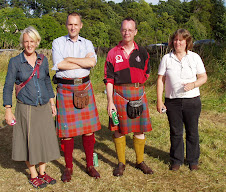I’m coming along nicely. The only way I have ever managed to deal with the yarns as I proceed, is the one The Master recommends – cut off about a yard at a time, so that you can just pull it through the tangle. It can be a slow and wasteful system, especially in a pattern like the Green Granite Blocks where the colour sections are large enough that a yard won’t do. For James’s sweater, I think, I could cut lengths appropriate to the task – and soon learned what they were.
Mary Lou, there is a sort of rhythm in intarsia knitting, at least if the pattern is geometric. I once tried one of Kaffe’s (few) patterns with cloud-like shapes. It might have been “Ancient”, in “Kaffe’s Classics”, and it was a Rowan kit. I hated every stitch, and abandoned it after about six rows – ripping back and using the yarn to knit his “Afghan” pattern in a big jacket for Helen. Very successful.
He says himself in the introduction to “California Patches” that “all of the designs here have a natural rhythm to knit that can quite quickly be committed to memory…” I sort of imagine myself weaving, or doing embroidery, when I’ve got into the swing of one of his patterns.
When “Glorious Knitting” first came out, I thought the same as you – I can’t do that stuff, beautiful as it is, and I’m not going to try. But then the “Crosspatch” vest turned up very cheaply, a Rowan kit in the January sales. And I got hooked. (Rowan kits often used to figure in the January sales, which has probably got something to do with why Rowan doesn’t do kits any more.)
Ron, I’ve found one flaw in the chart so far, a section for which no colour was specified. I’m sorry to hear your friend had such a struggle. I think I’d recommend anyone to start with Tumbling Blocks or one of its variations.
If I finish this one, that leaves one more kit in the stash, that vest based on the Ravenna mosaic. (It’s called “Mosaic”, and it’s in “Kaffe’s Classics” too.) Will that feel rhythmical to knit? Or is it too intricate? I love it, and must find out one day.
Somewhere in all that stash must be a bag of Rowan left-overs, the subtly-coloured fine yarns you can’t get any more. Maybe they could be combined into one last Classic Kaffe. Looking through the books again, I find lots that I admire but have never attempted. I am also inspired, by “California Patches” itself, to think again of his striped patterns.
I wondered for a while yesterday just when it was that I knit “Mini Roman Blocks” for James. The photograph I posted yesterday doesn’t come with a date. But then I remembered – I was knitting one of the sleeves on 9/11. I interrupted the pattern with two rows of purple. You can’t see the stripe in yesterday’s picture, so here is another one, in which it’s just visible, low on the right sleeve. It is supposed to be on the left sleeve but James has put the sweater on backwards.

And, oh yes, here’s the Chevron Scarf. Once wet, it was exactly the right size, no violent blocking necessary. There is no substitute for wool, like the man said. It looks curiously shortened in the picture, but I can assure you, it's the full five feet.




I suppose it's true I think of kitty cat pictures etc. when I think of intarsia. I do have a kit for a tumbling blocks pillow that I received for joining Rowan International one year long ago. You may have convinced me to take it out and try it.
ReplyDeleteMy friend is probably not the type to struggle through the patent process, marketing, manufacturing etc, but I will certainly convey your thoughts and compliments.
ReplyDeleteYou're right that intarsia is much simpler in geometric patterns-- anything that doesn't require slavish attention to a chart, really. No wonder the knitters of traditional colorwork, from Fair Isle and elsewhere, use patterns that are easily memorized and easily read as they are worked.
-- Gretchen
I am in awe of intarsia - I have never figured it out.
ReplyDeleteVery impressive sweaters!
The scarf is looking very good now - I can't see from the photo, but were you right that you only needed to shape the outer points and the rest follwed of their own acord?
ReplyDeleteNice intarsia..it does not look like a sweater,, is it really a sweater??
ReplyDelete